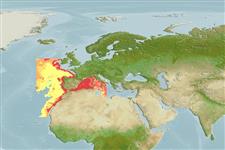Preferred temperature (Ref.
123201): 7.7 - 13.6, mean 12.9 °C (based on 84 cells).
Phylogenetic diversity index (Ref.
82804): PD
50 = 0.5161 [Uniqueness, from 0.5 = low to 2.0 = high].
Bayesian length-weight: a=0.00182 (0.00087 - 0.00380), b=3.05 (2.85 - 3.25), in cm total length, based on LWR estimates for this species & (Sub)family-body (Ref.
93245).
Trophic level (Ref.
69278): 3.9 ±0.1 se; based on diet studies.
Widerstandsfähigkeit (Ref.
120179): mittel, Verdopplung der Population dauert 1,4 - 4,4 Jahre. (Preliminary K or Fecundity.).
Fishing Vulnerability (Ref.
59153): Low vulnerability (16 of 100).
Nutrients (Ref.
124155): Calcium = 19 [4, 77] mg/100g; Iron = 0.333 [0.098, 1.121] mg/100g; Protein = 2.92 [0.00, 6.87] %; Omega3 = 0.18 [0.05, 0.61] g/100g; Selenium = 10.9 [3.3, 43.6] μg/100g; VitaminA = 37 [4, 304] μg/100g; Zinc = 0.566 [0.249, 1.390] mg/100g (wet weight);
